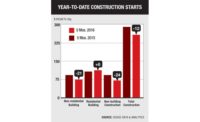
A Decline in Volume Follows a Strong December
The value of new construction starts fell 13% in January to a seasonally adjusted annual rate of $485 billion, according to McGraw Hill Construction Dodge. The downturn follows a strong December, which was the third-highest month for starts in 2013. On an unadjusted basis, total construction starts in January were $34.1 billion, which was down 5% from the same month a year ago. "Non- residential building in 2013 advanced 7%, but the progress was occasionally hesitant, including sluggish activity at the end of last year that carried over into January," says Robert Murray, MHC chief economist. "However, prospects for continued growth in that market during 2014 are positive," he adds. Growth in the housing market slowed 2% in January, after jumping 24% last year, says Murray.
D.C. Benchmarks Energy Use
The District of Columbia released benchmarking data on the energy and water performance of large, privately owned buildings, making it the second city to do so—New York City was first. The report includes 2011 and 2012 data on 450 commercial and multifamily buildings. Buildings included in the report scored an average of 77 out of 100 on the Energy Star scale, well above the median of 50. Between 2010 and 2012, buildings of more than 200,000 sq ft reported an average energy reduction of 6%. D.C. passed a law in 2008 that requires large public and private buildings to report benchmarking data. More than 83% of buildings required to report have done so. This year, the benchmarking requirement expands to all privately owned buildings over 50,000 gross sq ft.
EPA Enforcement Jeopardizes $8-Billion Mine Job
The U.S. Environmental Protection Agency has begun a process that could kill the nearly $8-billion Pebble Mine project in Bristol Bay, Alaska, currently in the planning phases. On Feb. 28, the EPA initiated a process under Section 404 (c) of the Clean Water Act to ensure the "pristine" waters of the world's largest sockeye-salmon fishery are protected. Until EPA completes its review, the U.S. Army Corps of Engineers cannot approve a permit for the mine, which would require a large, open pit and a large earthen dam to store waste from the low-grade copper excavated from the mine. The decision to initiate the review, which should take about a year, comes on the heels of the agency's scientific assessment, released in January, that concluded the construction of the mine and its associated infrastructure could devastate the sockeye-salmon population in Bristol Bay. Tom Collier, CEO of the Pebble Ltd. Partnership, the project's developer, blasted the EPA's "overreach." The EPA responded that it has used its authority only a limited number of times. "Bristol Bay fishery is an extraordinary reservoir and is worthy of out-of-the-ordinary agency actions to protect it."





